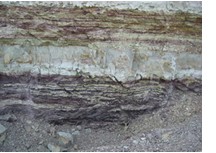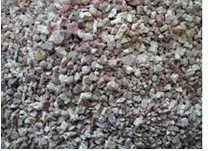 Bentonite is a rock formed of highly colloidal and plastic clays composed mainly of montmorillonite and is produced by in situ devitrification of volcanic ash. The transformation of ash to bentonite apparently take place only in water during or after deposition. In additional to montmorillonite, bentonite may also contain feldspar, biotite, kaolinite, illite, cristobalite, pyroxene, zircon, and crystalline quartz etc. Bentonite feels greasy and soap-like to the touch. Freshly exposed bentonite is white to pale green or blue, and, with exposure, darkens in time to yellow, red, purple or brown.
Bentonite is a rock formed of highly colloidal and plastic clays composed mainly of montmorillonite and is produced by in situ devitrification of volcanic ash. The transformation of ash to bentonite apparently take place only in water during or after deposition. In additional to montmorillonite, bentonite may also contain feldspar, biotite, kaolinite, illite, cristobalite, pyroxene, zircon, and crystalline quartz etc. Bentonite feels greasy and soap-like to the touch. Freshly exposed bentonite is white to pale green or blue, and, with exposure, darkens in time to yellow, red, purple or brown.
As the main content in bentonite, montmorillonite is aluminosilicate mineral with layered structure. The characteristic of bentonite is decided by the crystal structure of the montmorillonite. The structure cell formular of montmorillonite is 2Al2O3.8SiO2.2H2O .The basic crystal structure of montmorillonite is an octahedral alumina sheet between two tetrahedral silica sheets. These three-layer units are stacked one above another with oxygens in neighbouring layers adjacent to each other. This produces a weak bond, allowing water and other polar molecules to enter between layers and induce an expansion of the mineral structure. In the tetrahedral coordination, silicon may be substituted by aluminium and possibly phosphorus; in the octahedral coordination, aluminium may be substituted by magnesium, iron, lithium, chromium, zinc, or nickel. Substitutions by cations produce an excess of negative charges in the lattice, which is balanced by cations (Na+, K+, Mg2+, Ca2+) in the interlayer space. These cations are exchangeable due to their loss binding and, together with broken bonds, give bentonite a rather high cation exchange capacity. Variation in exchangeable cations affects the maxium amount of water uptake and swelling.
structure of montmorillonite is an octahedral alumina sheet between two tetrahedral silica sheets. These three-layer units are stacked one above another with oxygens in neighbouring layers adjacent to each other. This produces a weak bond, allowing water and other polar molecules to enter between layers and induce an expansion of the mineral structure. In the tetrahedral coordination, silicon may be substituted by aluminium and possibly phosphorus; in the octahedral coordination, aluminium may be substituted by magnesium, iron, lithium, chromium, zinc, or nickel. Substitutions by cations produce an excess of negative charges in the lattice, which is balanced by cations (Na+, K+, Mg2+, Ca2+) in the interlayer space. These cations are exchangeable due to their loss binding and, together with broken bonds, give bentonite a rather high cation exchange capacity. Variation in exchangeable cations affects the maxium amount of water uptake and swelling.
 According to this character, we processing technology to dry the bentonite, fully acting the function of adsorbing hydrated cations and moisture absorption to supply the nature high quality desiccant.
According to this character, we processing technology to dry the bentonite, fully acting the function of adsorbing hydrated cations and moisture absorption to supply the nature high quality desiccant.
Bentonite desiccant is from nature and it can be disposed directly as regular waste, after which it returns to nature. So it is a kind of efficient -low-carbon-green disiccant.




 +86 13163159081
+86 13163159081 kindpac@163.com
kindpac@163.com